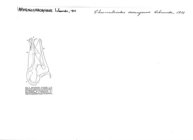MilliBase
MilliBase name details
Armeniobrachyiulus Lohmander, 1936
891028 (urn:lsid:marinespecies.org:taxname:891028)
uncertain
Genus
Chromatoiulus sevangensis Lohmander, 1932 accepted as Megaphyllum sevangense (Lohmander, 1932) (type by monotypy)
masculine
Lohmander, H. (1936). Über die Diplopoden des Kaukasusgebietes. Göteborgs Kungliga Vetenskaps- och Vitterhets-Samhälles handlingar, 5. Följden, Ser. B, 5(1): 1-196. Göteborg
page(s): 146 [details]
page(s): 146 [details]
Sierwald, P.; Decker, P.; Spelda, J. (2025). MilliBase. Armeniobrachyiulus Lohmander, 1936. Accessed at: https://millibase.org/aphia.php?p=taxdetails&id=891028 on 2025-07-07
Date
action
by
original description
Lohmander, H. (1936). Über die Diplopoden des Kaukasusgebietes. Göteborgs Kungliga Vetenskaps- och Vitterhets-Samhälles handlingar, 5. Följden, Ser. B, 5(1): 1-196. Göteborg
page(s): 146 [details]
status source Vagalinski, B.; Lazányi, E. (2018). Revision of the millipede tribe Brachyiulini Verhoeff, 1909 (Diplopoda: Julida: Julidae), with descriptions of new taxa. <em>Zootaxa.</em> 4421(1): 1-142., available online at https://doi.org/10.11646/zootaxa.4421.1.1
page(s): 121; note: Brachyiulini incertae sedis: "Lohmander (1936) erected Armeniobrachyiulus, a monotypic subgenus of Megaphyllum (=Chromatoiulus auct.), to incorporate this species. The author presented no diagnosis fo...
[details]
page(s): 146 [details]
status source Vagalinski, B.; Lazányi, E. (2018). Revision of the millipede tribe Brachyiulini Verhoeff, 1909 (Diplopoda: Julida: Julidae), with descriptions of new taxa. <em>Zootaxa.</em> 4421(1): 1-142., available online at https://doi.org/10.11646/zootaxa.4421.1.1
page(s): 121; note: Brachyiulini incertae sedis: "Lohmander (1936) erected Armeniobrachyiulus, a monotypic subgenus of Megaphyllum (=Chromatoiulus auct.), to incorporate this species. The author presented no diagnosis fo...
Brachyiulini incertae sedis: "Lohmander (1936) erected Armeniobrachyiulus, a monotypic subgenus of Megaphyllum (=Chromatoiulus auct.), to incorporate this species. The author presented no diagnosis for Armeniobrachyiulus, but he pointed out several gonopodal characteristics of M. sevangense he found sufficiently unusual to create the new subgenus. He also suggested close similarity to the subgenus Omobrachyiulus (here elevated to full genus) of Megaphyllum. Considering the description and drawings of M. sevangense (in Lohmander 1932 & 1936), this looks plausible, especially if the basal protrusion on the anterior side of the opisthomerite in M. sevangense can be regarded as homologous to the better developed mesomeroidal lobe in members of Omobrachyiulus. Examination of females is of key significance for clarifying the systematic position of the species. Revealing the vulval characters would either support or refute its assignment to Megaphyllum."
